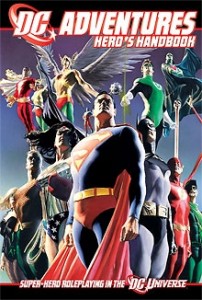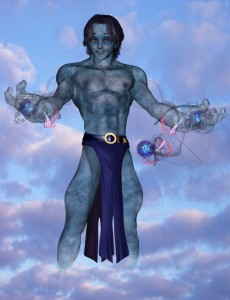 Last time we looked at what makes superhero gaming different (some would say superior, but that’s fightin’ talk) to other genres of role-playing. This turn around, it’s time to get down & dirty and take a close look at how Mutants & Masterminds Third Edition might just be the ideal system for your first foray into the world of the spandex’d hero.
Last time we looked at what makes superhero gaming different (some would say superior, but that’s fightin’ talk) to other genres of role-playing. This turn around, it’s time to get down & dirty and take a close look at how Mutants & Masterminds Third Edition might just be the ideal system for your first foray into the world of the spandex’d hero.
For those of you that have played previous editions of M&M, I suggest you stick around, too. You’ll learn a little of what makes this edition even better than what came before. Steve Kenson has achieved the impossible, improving an already fantastic (nay, perfect) game. I’ll show you how, and what to look out for, as you turn the page.
In order to play M&M3e (an unwieldy acronym, but less tiring than typing Mutants & Masterminds Third Edition repeatedly) you need just one book: the core rules. This comes in a choice of two flavours – DC Adventures, which contains the entire rules system coated in wonderful DC Comics campaign setting fluff and artwork, or the vanilla all-you-can-eat Mutants & Masterminds Hero’s Handbook, which doesn’t. Both are available as either print (DC Adventures is hardcover, the Hero’s Handbook is softcover, and coming soon) or pdf. Of the two, DC Adventures is better value overall. The pdf is $20 (just $2.50 more than the Hero’s Handbook) and the Hardcover $40 ($7 more than the softcover Hero’s Handbook), but has better artwork (which is to be expected) as well as full stats for Batman, Superman & co. What’s not to love?
Compared to the World’s Most (or Least, depending on who you ask) Popular Role-Playing Game, M&M3e is an absolute bargain. There are other, simpler, cheaper superhero systems out there (ICONS is a terrific game, and at only $2 should be on every gamer’s hard drive) but M&M3e, like D&D, is The Daddy. It is the game to which all others aspire, the one which has (in our group, at least) overtaken all of the other superhero systems out there (and there’s no shortage of great ones right now) and we turn to time and again.
Where M&M3e differs from Second Edition is that it has taken a step away from the core d20 system as laid down by the D&D System Reference Document, and become more of a unique game in its own right. This is a Good Thing as it means the emphasis is placed more on elements that need pushing to the fore in the superhero genre.
For example, instead of just a single Dexterity stat, there are three: Agility (speed, grace and overall body control), Dexterity (manual dexterity and fine motor skills) and Fighting (the raw ability to hit or avoid a blow). This lets you create a character who is highly dextrous, but lacks combat talent (a Stage Magician, for example), a clumsy pugilist or acrobat (who lacks both fighting and manual dexterity skills). In previous editions, as with D&D itself, you would either have to create a character with high DEX and hand-wave their shortcomings, or use Feats and Skill Training to represent what should be natural talent (ie, Attribute-based).
The other changes to the system are likewise evolutionally rather than revolutionary in nature, and each one is an improvement over what has gone before. Feats are renamed Advantages and cover much the same ground, the Skills list is more tightly focused toward modern-day gaming and terminology, many of the Powers have reworked costs and mechanics, and all characters gain two Complications during character generation (which can act as plot-fodder for the GM). None of these are particularly earth-shaking, unless you’ve got Earth-Shaking as a Power, of course.
The biggest conceptual change is back with the attributes. In D&D terms, M&M3e just uses the Attribute Bonus as the stat. For example, STR 4 in M&M3e terms is the same as STR 18 (a +4 bonus) in D&D and previous editions of M&M. This change works especially well in the superhero genre where heroes (and villains) can have attributes far beyond human limitations.
This is the edition of Mutants & Masterminds where it grew up and learned to stand on its own two feet. Bless.
Enough of the mini-review. This is meant to be a beginner’s guide, so let’s start at the beginning. Again.
As with every RPG under the sun, your M&M3e experience is likely to begin with character generation. Mutants & Masterminds contains no classes, no races and none of the coat-hooks your typical D&D gamer will expect to be able to hang his hat on. That blank character sheet and pool of Points you spend to create your character from scratch can look awfully intimidating, so that’s why M&M offers up Archetypes. These are entirely optional pre-built character templates that the player can use as-is, adapt or draw from as inspiration. There’s no mechanical benefit to using an archetype (their points cost is calculated the same), but they do provide a quick and simple way of getting into the game. Imagine if the D&D Player’s Handbook included pre-generated character stats for an Elf Ranger, Human Wizard, Dwarf Fighter and Halfling Rogue, all ready to add a name to and play. That’s what Archetypes are in M&M. The ones provided are:
- Battlesuit – Because everyone wants to play Iron Man, right?
- Construct – You were made, not born. That means no birthday presents. Boo you.
- Crime Fighter – You are a member of Batman Incorporated and want to be Nightwing or Batgirl when you grow up
- Energy Controller – Covers everything from the Human Torch to Cloak & Dagger or Lightning from the JSA
- Gadgeteer – I got your steampunk mixed in my superheroes
- Martial Artist – I got your Bruce Lee mixed in my superheroes
- Mimic – Anything they can do you can do, too
- Mystic – Doctor StrangeFate!
- Paragon – The iconic Superman who can fly faster than a speeding ticket and punch through walls
- Powerhouse – Big, strong and ugly
- Psionic – I know what you’re thinking. Stop that
- Speedster – Can run at 64,000mph, thus making battlemat-using GMs cry
- Shapeshifter – Proving that one size doesn’t fit all
- Warrior – You are Aquaman, Ravager, or Conan
Phew! The Archetypes cover a huge number of superhero types and there’s bound to be at least one that appeals. As this is a Beginner’s Guide, I recommend picking an Archetype, then (if you’re feeling brave) customizing it a touch. Juggle the skill points around, switch out a Power or two, or change the Advantages. Add your own personal Complications, and you’re done.
Full blown start-with-a-blank-character-sheet generation is beyond the scope of this post, but it’s great fun to craft your own unique one-of-a-kind superhero. If you prefer pixels over pencil and paper, I heartily recommend Hero Lab. It is one of the best (if not the best) character generation applications around, and will create characters for M&M2e, M&M3e, Savage Worlds, Pathfinder and more. Well worth a look.
The most important part of character generation (whether you go the Archetype route or no) is to consider the team. Superhero gaming is, more than any other genre, about being a member of a group. You are a vital member of a superhero team who relies on each other to save lives, protect the innocent, and mash nasty villains into pulp. Think about how your powers and personality contribute to the team as a whole. Every one wants to be Batman, but no one wants to be the rest of the team that Batman is on. It might be cool to play the moody solo hero stuck in a team situation, but don’t be That Guy. At least, not for the first few sessions where you are all learning the game, ‘kay?
I’ll end with a quick example of character generation at work.
 Meet Imagenie, a genuine honest-to-goodness Genie exiled from the Djinn City of Brass for questioning the authority of the High Council. In human terms, he is a teenager (albeit a 200 year old one) and would fit right in to a group such as the Teen Titans.
Meet Imagenie, a genuine honest-to-goodness Genie exiled from the Djinn City of Brass for questioning the authority of the High Council. In human terms, he is a teenager (albeit a 200 year old one) and would fit right in to a group such as the Teen Titans.
His main strength is his keen insight into other people – he has a high Awareness and terrific Deception and Insight skills that mean it’s almost impossible to pull the wool over his eyes. In a team, he is the guy in whom all the others confide – even when he is secretly pulling the strings behind their backs.
His powers are all wind-based. He can create tornadoes that he can fix in place or move around, let loose blasts of air, have it swirl around him or create “platforms” of air to carry himself and others. The wind-creations all seem to shimmer like half-created illusions, often of desert scenes and minarets. As he advances, he will gradually gain Illusion-based powers and truly come into his own as an adult Genie.
= Imagenie, PL8 120pp =
Str 2, Sta 3, Agl 4, Dex 6, Fgt 4, Int 4, Awe 8, Pre 6
Dodge 5, Parry 5, Fort 4, Tough 3, Will 12, Init +4
Close Combat 6, Deception 14, Insight 12, Persuasion 8, Ranged Combat 8, Sleight of Hand 8
Create 8 (200′, 250cu’, DC 18, Innate, Mobile, Stationary)
– AP: Blast 8 (200′ DC23, Area 60′)
– AP: Protection 8
– AP: Flight 8 (500mph, Platform, Affects Others)
Complications: Questions authority, Motivation: Find a way to return home

Interesting stuff. I’ve always been interested in Super Hero P&P but never ended up getting involved. I like the ideas laid out about the M&M3e system. I’ve always been a fan of flaws as mechanics so thats an immediate plus for me. I hope to try out a system or two and PAXEast.
What I do have experience with is City of Heroes. Never have a played again that not only encourages you to team, but makes it fun, easy and dynamic. As you point out a bit, this is exactly what a super hero game should thrive on.
Its interesting that you compare things to D&D, only because I find playing 4e often feels like playing D&D: SuperHeroes! PCs now have unique abilities, called powers, that make them larger than life, no matter the class. I’ve even thought about running a modern superhero game using the 4e system, since my players are already familiar, and just changing the descriptions.
Yup. Definitely going to try to get into a Supers game at DunDraCon. It’s been years since I played Heroes Unlimited, and I miss the genre (not Heroes Unlimited, though).